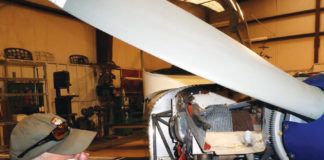If you’re thinking of building a composite airplane, you should be aware that its built roughly in thirds. The first third of your time will be spent assembling the airframe. How long that takes is up to you and the designer of the kit. The second third is spent installing the systems, most notably the instrument panel. Again, thats up to you. Are you a fast worker? Are you building it for day VFR around the patch or transcontinental competition with the airlines? The third third, if you will, has little to do with the first two: Its the finishing. Of course you are proud of your accomplishment, but is the goal to build a sleek little gem that gathers trophies faster than bugs on a Kansas evening, or do you want air under you and runways disappearing behind?
That old saw of being 90% done, 90% to go was never more apropos than in relation to the last third of the project. If it were an aluminum airplane, youd just wash, dry, prime, paint and fly. (Sure, thats a pretty broad generalization, but you get the idea.) You can do that with glass, too, if you’re not too particular about the finish. But if you want to be invited to park next to the runway at Oshkosh, youd best be prepared to spend some time coming into the house perfecting your Jack-Nicholson psycho rendition of “They’re baaaack.” Whats back? Pinholes.
I know, I know. At the outset of this series I said something along the lines of building a beautiful glass airplane cant be that hard, after all there are so many of them. And Ill stick by that. It doesn’t take a Ph.D. in polymer technology. It does take a little grunt work and a lot of working smarter by using the right technologies.
Find the Pinhole
Pinholes are the inevitable result of using a porous material. Some pinholes are voids in the final layer of surface, which might be primer or gel coat, but might also be nothing at all because some fiberglass components outer surface is simply the last exterior layup done or the final layer of glass-and-glue next to the mold.
So what does a pinhole look like? How big is big enough to ruin your paint? As it turns out, the answer is: It depends. It depends on your tolerance level of course, but it also depends on your patience to let the filler material cure before painting. It also depends on how hot the weather is. Ill get into those factors a little later, but for now take a good look at the pictures to see what were talking about.
I spent some time with the guys at AirCrafters in Watsonville, California, to get the point of view of those with years of experience and see what they liked. When I asked for the expert, they all pointed to Jesus Gomez, aka Chuy. He suggested several products, but his emphasis was on preparation and technique to first avoid creating more pinholes instead of trying to eliminate them later. Once thats mastered, it makes filling the little monsters a bit easier.
Keep It Clean
First, lets look at the technique. The watchword is “clean.” Any oil or dirt will create a pinhole in the paint where there was none on the bare glass. Its easy enough to remedy; just get it clean, really clean. How clean? Start by sweeping and vacuuming the entire shop. Without this step you’ll only frustrate yourself by kicking dirt into the air as you walk around the part, going at it with acetone and new rag. Wipe the plane down at least twice, too.
Then he likes to give the part a misting of black paint followed by a light sanding to remove the black on the surface. Whats left is in the pinhole. Another method is to squeegee a layer of red or black glazing compound over the surface. Assuming the surface is white, or at least light colored, the pinholes will show up like acne the night before the high school prom.
Product Placement
Gomez then likes to use a body filler called Rage. Its a lightweight version of Bondo thats usually employed to do fine fillets. In this case, he goes at with a squeegee to lay on a coating as thin as possible. “This is where most beginners goof,” he said. “They think they can just slap it on and sand it back down.” Thats a mistake, he says, because using this poor technique results in the Rage not being forced into the cavity; its just layering over it.
He also advises that if you want to use it for filling the larger divots or creating a radius in a corner, it should not be applied more than one-eighth of an inch thick. “Itll crack as it dries,” he says. I checked with another friend whos flying his sixth composite airplane, Jim McCormick of Jabiru Pacific. He learned a lot in the course of all that work and was quick to admonish me when I suggested wet sanding. “No! No! No!” he said. “That creates a very good paste that fills in the pinholes just fine, but it doesn’t adhere to the base material. When it dries out, it falls out and your pinhole is back.”
A search of web chat room discussions consistently confirmed the use of Rage and also uncovered the name PolyFiber. I called PolyFiber, explaining that I was researching the subject and would like to speak to someone with technical know-how.
A conversation with Jon Goldenbaum, self described gofer, trash guy and janitor at Consolidated Aircraft Coatings, aka founder and CEO of the company that makes the PolyFiber line of products, was a wealth of information.
“So, whats the cause of pinholes?” I asked.
“Three causes, Bob. First, there’s prepreg. Even though the fabric is completely soaked with resin, a lot of it is squeezed out, leaving a texture due to the weave, and you can feel the ridges of the yarn. Second, the epoxy sometimes outgases, leaving tiny bubbles at the surface. And third, a simple, unfilled void in the cloth where it didn’t get sufficient resin to wet out…a dry spot.”
The PolyFiber Solution
The company has two products of interest: UV Super Fine and SuperFil.
Goldenbaum explained that the most apparent difference between the two products is their viscosity: UV Super Fine is near water, and SuperFil is a bit thicker. He went on to explain that though SuperFil has been on the market longer and is, therefore, more popular, it could stand a couple of improvements. The result is that they concocted UV Super Fine not as a replacement, but as a dedicated filler of pinholes. The reason for this is that if the pinholes are large enough, most coatings-including paint, Bondo and even SuperFil-will simply follow the contour of the hole, resulting in a wing surface with the appearance of the tee-off point at a Smurf golf course: little divots everywhere. You could cover them, but compressing that tiny amount of air will only cause a tiny bump that you’ll want to sand down. The result is a tiny pinhole with a cavern underneath. The
solution is to fill the holes, not cover them, which is what Gomez said.
The reverse of that problem was also explained. “Bondo-type products are too heavy in viscosity to get into those small cavities,” Goldenbaum said. “For SuperFil to do this job, you have to really squeegee it in. A lot of our customers didn’t understand this and were slathering it on like it was frosting on a cake. Thats fine if you want to fill seams and use it to create corner radii, but not for filling pinholes. So we came up with UV Super Fine.” The liberal use of wetting agents causes it to flow out, adhering to the surfaces and filling in the pinholes. This allows the user to apply it either by spray or to indulge in a heresy, applying it with a foam roller. Hey, it works, its cheap, its fast and clean-up is a snap. In fact, Goldenbaum says it works better than spraying because it really squeezes the material into the holes. Just don’t let your flying buddies see you going at your Bugsmasher VI with a roller and then expect less than a razzing.
Dont Race for the Cure
There’s an adage that says, “If it sounds too good to be true, it probably is.” Here, too, that maxim applies. You have to wait for UV Super Fine to dry at least three weeks, longer in humid weather, and invest in a dehumidifier while you’re at it. “Our job is to watch paint dry,” Goldenbaum said.
This is where the patience issue comes in. The UV Super Fine, along with many other products, has to be 100% cured before you apply the paint. Rush it and the filler will continue to shrink, pulling the paint down with it.
Similarly, if its not fully cured and you leave the airplane out in the hot sun, the filler shrinks unduly and can force the pattern of the glass cloth up through the paint. But then maybe you like that effect…just add a Levis label and call it a feature. The offset, though, is that you can watch the filler dry for three weeks, or you can fill-sand-fill-sand for three weeks or more if the paint gods are displeased.
If you have the front-row-at-the-airshow obsession, you’ll have to have a go with SuperFil to get the little radii that make the airframe appear to be blow-molded in one piece. After that, you will need to seal the surface with a two-part epoxy primer and then allow it to cure for another week.
But thats literally a discussion for next month, when we wrap up our Build Your Skills: Composites series by taking you from the done-with-pinholes stage right to the last steps in preparing the final skin of paint. Just as with pinholes, technique and patience play starring roles.
For more information about AirCrafters builder assistance, call 831/722-9141, or visit www.aircraftersllc.com. A direct link can be found at www.kitplanes.com.












